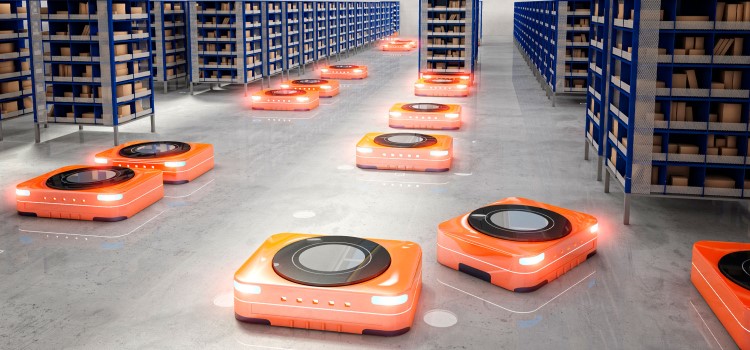Intelligent Autonomy: A Deep Dive into the Innovations Reshaping Mobile Robotics
17-Sep-2024

Introduction
In the era of rapid technological progress, the mobile robot industry is leading the way in terms of innovation. It is majorly driven by the integration of cutting-edge technologies. These advancements are not only reshaping the capabilities of mobile robots but also expanding their applications across various industries. Let's explore the transformative technologies that are steering the evolution of mobile robots.
Artificial Intelligence (AI): Unleashing Intelligent Autonomy
Artificial Intelligence (AI) stands as the fundamental driving force behind the enhanced intelligence of mobile robots. The incorporation of machine learning algorithms helps these robots in learning, adapting, and making smart decisions, revolutionizing their capabilities.
With AI, mobile robots excel in navigating intricate environments, optimizing their performance, and even acquiring knowledge from past experiences, significantly advancing their autonomy.
A notable recent development in this field is the introduction of Swarm Autonomy by FARobot, representing an enterprise automation platform tailored for intralogistics. This innovative software solution, developed in collaboration with FOXCONN's manufacturing big data and ADLINK's domain insight, leverages AI algorithms and 3D vision cameras.
The primary objective is to streamline and expedite the commissioning process, achieving a remarkable reduction of up to 20% in commissioning time. The platform is strategically designed to synchronize shop floor equipment within factories and warehouses, ultimately elevating operational efficiency and throughput.
FARobot's Swarm Autonomy highlights the significance of AI in mobile robotics and showcases the practical implementation of these technologies in real-world scenarios. By harnessing the power of AI algorithms and 3D vision cameras, this platform exemplifies a cutting-edge solution for intralogistics. This is where the fusion of data insights and advanced robotics leads to tangible improvements in efficiency and productivity.
Machine Vision: Seeing the World through Robotic Eyes
Machine vision is equipped with cameras and sensors, enabling mobile robots to interpret and navigate their surroundings precisely. This technology allows robots to recognize objects, avoid obstacles, and execute tasks with a level of accuracy that was once unimaginable. Recently, MRDVS introduced its latest 3D vision cameras, the S2 obstacle avoidance camera and the M4 docking camera, at CIIF.
These cameras enhance the operational efficiency of mobile robots with features, such as intelligent obstacle avoidance and vision-based docking. They cater to the increasing demand for advanced vision solutions in the AGV/AMR industry.
LiDAR: Navigating with Laser Precision
Light Detection and Ranging (LiDAR) technology is revolutionizing navigation for mobile robots. By utilizing laser beams to measure distances and create detailed 3D maps, LiDAR-equipped robots can autonomously navigate, avoid obstacles, and operate seamlessly in dynamic and complex environments. For example, ResGreen Group International (RGGI), an autonomous mobile robot (AMR) development company, implemented 2D and 3D LiDAR systems to enhance its operations.
This development showcases the company's commitment to leveraging advanced technology for its robotic solutions. The utilization of LiDAR systems is a significant step forward in improving the navigation and obstacle avoidance capabilities of AMRs, contributing to their overall efficiency and safety.
SLAM: Mapping the Uncharted Territory
Simultaneous Localization and Mapping (SLAM) algorithms enable mobile robots to create maps of unknown environments while simultaneously determining their position within those maps. This technology is a game-changer for autonomous navigation, allowing robots to explore and adapt to new surroundings.
In 2023, ABB Robotics launched Visual Simultaneous Localization and Mapping (VSLAM) technology for its AMRs. The technology enables ABB AMRs to make intelligent path-planning and obstacle-avoidance decisions based on their surroundings. VSLAM uses AI algorithms and 3D vision cameras to perceive the world around the AMR in a three-dimensional representation. This reduces commissioning time by up to 20% and requires less calibration and no change to infrastructure.
5G Connectivity: Real-Time Communication Revolution
The integration of 5G connectivity empowers mobile robots with high-speed and low-latency communication. This is particularly crucial for applications requiring real-time data transfer, such as remote operation and control, enhancing the responsiveness and effectiveness of mobile robotic systems. For example, Turkcell and Ericsson introduced a 5G-supported AMR solution. The collaboration aims to provide a seamless and efficient experience for AMRs in various industries, such as manufacturing, logistics, and healthcare. The 5G-supported AMR solution enables real-time data transfer and communication between the robot and the cloud, allowing for rapid decision-making and improved performance.
In conclusion, these remarkable technologies are transforming the mobile robot industry. As these innovations mature, mobile robots are poised to play increasingly vital roles across diverse industries, ranging from manufacturing and logistics to healthcare and beyond. The future promises a landscape in which intelligent, adaptive, and collaborative robots contribute to unprecedented advancements in efficiency, safety, and productivity. Welcome to the age of intelligent robotics!
About the Author
 Shyam Gupta is a passionate and highly enthusiastic researcher with more than four years of experience. He assists clients in overcoming difficult business challenges by providing actionable insights through exhaustive research. He has closely monitored several industries, such as Consumer Electronics, Robotics, and Electric Vehicles. He has a keen interest in writing articles and uses blogs as a medium to share his thoughts. He spends his time reading and painting when not keeping up with industry news. The author can be reached at info@nextmsc.com
Shyam Gupta is a passionate and highly enthusiastic researcher with more than four years of experience. He assists clients in overcoming difficult business challenges by providing actionable insights through exhaustive research. He has closely monitored several industries, such as Consumer Electronics, Robotics, and Electric Vehicles. He has a keen interest in writing articles and uses blogs as a medium to share his thoughts. He spends his time reading and painting when not keeping up with industry news. The author can be reached at info@nextmsc.com






